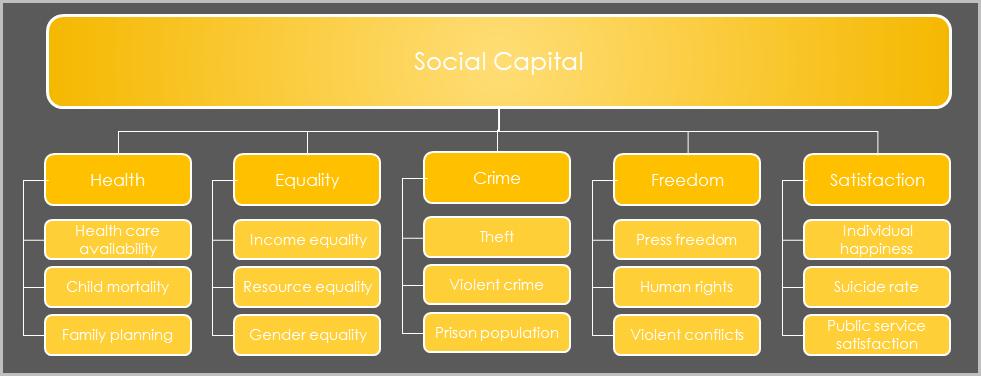
3 minute read
6 SOCIAL CAPITAL INDEX
The Social Capital of a nation is the sum of social stability and the well-being (perceived or real) of the entire population. Social Capital generates social cohesion and a certain level of consensus, which in turn delivers a stable environment for the economy, and prevents natural resources from being overexploited. Social Capital is not a tangible value and therefore hard to measure and evaluate in numeric values. In addition to local historical and cultural influences, the social consensus in a society is affected by several factors: health care systems and their universal availability/affordability (measuring physical health); income and asset equality, which are correlated to crime levels; demographic structure (to assess the future generational balance within a society); and freedom of expression, freedom from fear and the absence of violent conflicts that are required for businesses to be able to generate value.
While a direct connection of social cohesion to creating wealth and sustain economic development might be difficult to establish scientifically, a certain degree of equality, adequate health systems, freedom from fear and equal opportunities (without which no American Dream ever would have been possible) are pre-requisites to achieve the same. The absence or deterioration of social cohesion in turn leads to lower productivity (health), rising crime rates, and potentially social unrest, paralysing economic development and growth.
Advertisement
S o c i a l C a p i t a l I n d i ca t o r s
The indicators selected to measure social cohesion have been selected from the 5 themes above (health, equality, crime, freedom and age structure). Some of these indicators (e.g. “happiness”) are qualitative, i.e. not based on performance data that can be measured. Instead, qualitative indicators from surveys and other sources compiled by recognised organisations were used to measure the qualitative aspects of social cohesion, including single indicators from the Happy Planet Index (New Economics Foundation), the Press Freedom Index (Reporters Without Borders), and the Global Peace Index (Institute for Economics and Peace). For the full list of used indicators, please refer to the methodology section.
Key elements of competitiveness drivers in the Social Capital SubIndex
S o c i a l C a p i t a l W o r l d M a p
A certain level of social balance or social consensus is required to maintain a stable environment in which economic activities can take place. The higher the social capital of a country, the better the economy can flourish. The higher the social consensus, the higher the motivation of individuals to contribute to the wider good, i.e. the sustainable development of the nation – and the less likely they are to fall off the track into illegal paths of wealth generation that eventually hurt the legal economy. The indicators used to calculate the Social Capital score of countries is composed of health and health care factors (availability and affordability), the quantitative equality within societies (income, assets, and gender equality), freedom indicators (political freedom, freedom from fear, individual happiness), crime levels, and demographic indicators.
• The top 20 in the Social Capital sub-index is dominated by European countries from the North (particularly Scandinavia) – only Japan (13), Singapore (13) and South Korea (17) break into the ranks • The USA, due to comparable high crime rates, low availability of health services, and rising inequality, is ranked 109, just below Jordan and above Dominican Republic. • The UK is ranked 43, reflecting the deteriorating social fabric. • China is ranked 31, India 137, Russia 99, and Brazil 123 • The highest ranked South American country are Costa Rica (62), Argentina (66) and Ecuador (69); the highest-ranking African country are Senegal (80) and Burkina Faso (83). Most African nations, particular within and south of the Sahel zone, are at the bottom of this list, due to a combination of low availability of health care services and child mortality, limited freedom of expression, and unstable human rights situation

S o c i a l C a p i t a l I n d e x 2 0 2 0

Achieving Sustainable Competitiveness













